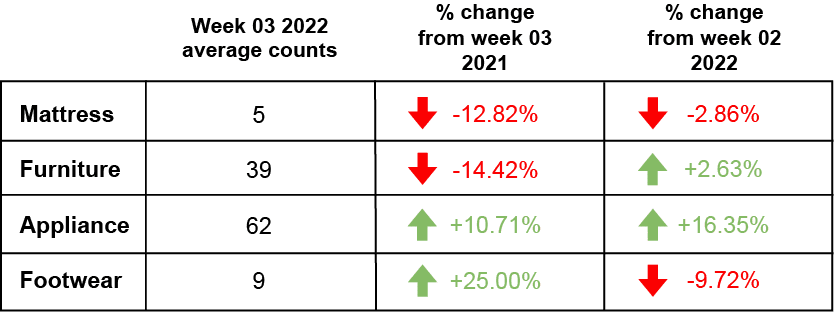Despite lackluster foot traffic on what are usually high traffic days, holiday sales in the U.S increased 11% from 2019.
What this data doesn’t capture, is all of the people who bought online but still went to the physical store, whether going inside or curbside, to pick up their order.
This week we dive into consumer trends that are slipping through the data and changing the shopping experience.
THIS WEEK’S HIGHLIGHTS
- DOORCOUNTS WEBINAR TODAY: Join us today at 12 pm EST for our weekly webinar. CLICK HERE TO REGISTER FOR WEBINAR.
- Changing shopping trends: How relationship commerce is reshaping retail.
- The world of returns: Why 16.6% or $761 billion in merchandise sold in 2021 is expected to be returned.
FOOT TRAFFIC INDEX
Here’s a look at last week’s foot traffic compared to the same time last year.

FOOT TRAFFIC TRENDS
Industry insights so you can convert your foot traffic into more sales.
Five Trends Changing The Way Customers Shop In 2022
According to data from Sensormatic Solutions, Thanksgiving foot traffic was down 90% in 2021, and traffic on Black Friday was down 28% from 2019.
Even with lackluster foot traffic on what are usually high traffic days, holiday sales in the U.S increased 11% from 2019.
As we said earlier, foot traffic data doesn’t capture all of the people who bought online but still went to the physical store and utilized curbside pickup. Although foot traffic data may not show it, emerging trends such as BOPIS and curbside pickup have changed the way consumers shop.
While online shopping isn’t new, the trend of shopping on mobile devices has skyrocketed in the last few years. According to Shopify’s yearly reports, mobile orders have accounted for over half of Shopify’s sales since 2014.
Not only has the way people shopped changed, but the beliefs that fuel their purchase has also changed. In the U.S., 71% of millennials say climate change is our most pressing social issue and are more likely to buy sustainable goods.
Click Here to read about more trends that are changing the way consumers shop.
The world of returns
Total retail sales reached $4.583 trillion in 2021. Out of the $4.583 trillion, 16.6%, or $761 billion in merchandise is expected to be returned.
In general, the total rate of return has increased since the 10.6% reported in 2020. A major reason for the increase in returns is due to the increase in e-commerce sales in 2021, which have a higher rate of return compared to in-store purchases.
For every $1 billion in sales, the average retailer incurs $166 million in merchandise returns.
The industries expected to see the most returns are Auto parts (19.4%);
Apparel (12.2%); and Home improvement and housewares (tied at 11.5%). Thankfully, retail analysts expect consumers to return to shopping in-store more than we saw in 2021.
Click HERE to learn more about what analysts expect to see in 2022.
Retail Snippets
Study: Why marketplaces attract valuable ‘power shoppers’.
Today in Data: How relationship commerce is reshaping retail.
The frontier: These 10 brands are proving physical stores still matter in 2022.
A new look: Retailers use digital blueprints to reinvent the physical store experience.
RANDOM IRRELEVANCE
Wordle: The best starting words to use and other game tips.
Regeneration: Scientists were able to regrow frog legs. Will it pave the way for regeneration in people?
Digital stylist: This extremely toxic lake could show us how life may have survived on Mars.
